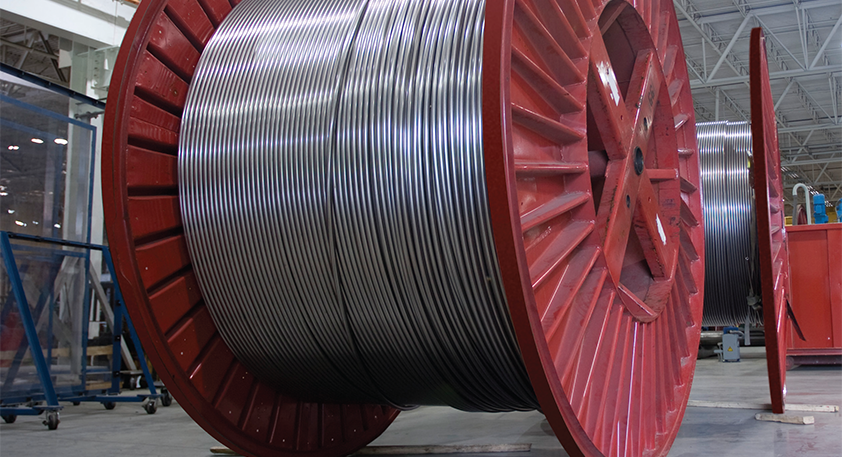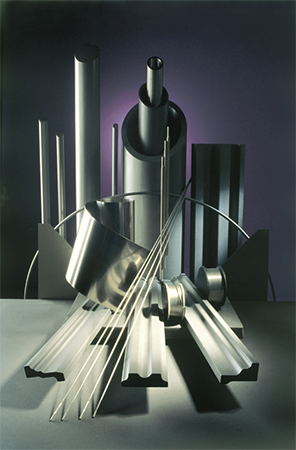
RathGibson a PCC Energy Group company
Reaching deep
New emergence for the subsea industry
For over five decades, RathGibson has been a key supplier to the oil and gas industry. In the past twenty years, the company has provided control line and umbilical tubing for numerous applications, including flying leads (hydraulic and electrical), electrical lines, chemical injection lines, and hydraulic lines. In addition to straight length and U-Bend tubing, RathGibson’s cost effective solutions include coiled tubing that combines the high strength of lean duplex with the anodic corrosion protection supplied by zinc.
Expertise from integration – The PCC Energy Group
The PCC Energy Group, a member of the Precision Castparts Corp., acquired RathGibson in March 2012. RathGibson was chosen because of its outstanding capabilities that complement PCC’s portfolio of offshore products. The PCC Energy Group provides raw material and components integral to oil country tubular goods (OCTG) products, blowout preventers (BOPs), high pressure/high temperature (HP/HT) pressure control equipment, manifolds, splash zone piping, and risers and flexjoints.
The well-respected and recognised brands of The PCC Energy Group offer a wealth of products and combined expertise necessary for meeting the growing challenges of the oil and gas industry. These include Wyman Gordon, which produces complex forgings and extruded shapes in a variety of metals and alloys, Special Metals Corporation, which produces the most complete range of nickel and cobalt alloy compositions and product forms from a single manufacturer, Special Metals Welding Products Company, WG Hackney Ladish, KLAD Manufacturing, and PCC Rollmet.
Visit www.pccenergygroup.com for more detailed information.
Meeting the vast needs of the industry
RathGibson has developed a reputation that is unparalleled in the industry, and is recognised by key players including Shell, BP, ExxonMobil, Chevron, Petrobras, LLOG, Dominion, Anadarko, ToTal, Husky Oil, Petro Canada, McMoRan, Apache Oil & Gas, China National Oil Co., and Nippon Oil, in addition to major service companies such as Halliburton, Baker Hughes, Schlumberger and Weatherford. Others include Bharat Heavy Electricals Ltd. (BHEL), Dubai Electricity & Water Authority (DEWA), Godrej & Boyce (India), Larsen & Toubro (India), Oxy (Oman), Qatar Gas and Reliance Industries, and Saudi Aramco.
RathGibson provides an enormous selection of tubing alloys, including INCOLOY® alloy 825, 316L, Duplex 2205, INCONEL® alloy 625, and Zinc Clad Lean Duplex 19D for oil and gas applications, including subsea umbilicals, downhole controls, and tubing encapsulated conductor (TEC) lines. Pressure and corrosion tubing is available in 1/16″ (1.59 mm) to 4″ (101.6 mm) outer diameter (OD) and 0.010″ (0.25 mm) to 0.220″ (5.59 mm) wall thicknesses. Pressure coils up to 80,000’ (24 km) are available with minimal girth welds. Instrumentation tubing is offered in 1/16″ (1.59 mm) to 1/2″ (12.7 mm) OD and 0.010″ (0.25 mm) to 0.065″ (1.65 mm) wall thinknesses.
 Coiled tubing
Coiled tubing
Hundreds of millions of feet of RathGibson’s quality coiled tubing has been deployed in land and offshore oil and gas well installations worldwide. RathGibson’s coiled tubing is produced with outer diameters up to 1-1/2 inches wide, in lengths up to 6,000 feet without orbital welds. To manufacture coils up to 80,000 feet long or to remove defects, RathGibson employs both laser and Tungsten Inert Gas (TIG) seam welding and TIG orbital welding. After welding, X-ray examination is performed to ensure weld integrity.
Subsea umbilicals
RathGibson’s umbilical tubing is currently installed in waters up to 7600’ (2.3 km) in depth and lengths up to 32.5 miles (52.3 km). It is employed in both dynamic and static subsea applications where high strength and corrosion resistance are essential.
The increasing water depths and higher working pressures make subsea an extremely harsh environment. Laser welded Lean Duplex 19D provides a cost-efficient alternative for subsea umbilical application. Its lean composition generates lower costs, but makes its less compatible for the subsea environment. A zinc-cladding is added to provide an improved external protection. Since 2001, RathGibson has placed over 4500 miles of its zinc-clad lean duplex welded tubing in dynamic and static subsea umbilical applications. Coating wall thickness for the zinc is typically 0.030 inches. The largest reels are 67,000 feet (20.4 km) in length.
RathGibson’s zinc cladding of umbilical tubing begins with the grit blasting of the tube’s outer surface. By simultaneously feeding the tube with a zinc rod through a die at a specified temperature and pressure, the zinc bonds to the tube’s exterior to provide cathodic protection against corrosion. Then the tube is cooled, stenciled, and coiled on large reels. Before shipment, RathGibson’s umbilical tubing undergoes multiple physical tests, including x-ray, ultrasonic, and Final Acceptance Testing (FAT).
Downhole controls
RathGibson’s outstanding tubing offers precise downhole control of surface controlled subsurface safety valves (SCSSV) and chemical injection mandrels. The safety valve, which is located downhole below the mudline, is controlled hydraulically from the surface. Although normally a closed apparatus, the valve is designed to open and shut the well if there is a distinct loss of control pressure. This fail-safe device is critical for isolation of the wellbore in case of an emergency, such as system failure or damage to the surface control facilities. RathGibson provides tubing for the  retrievable SCSSV with entire assembly installed within the tubing string.
retrievable SCSSV with entire assembly installed within the tubing string.
The chemical injection mandrel is composed of a port and check-valve system to direct chemicals, such as inhibitors for paraffin, hot wax, hydrates, and asphaltenes, into the production conduit. A surface operator pushes chemical into RathGibson tubing, which is secured within the inner diameter of the production string, same as the SCSSV. The chemicals provide vital functions, such as inhibiting substances that negatively impact production and reducing the effects of corrosion.
TEC lines
Used in conjunction with control line tubing, TEC lines provide maximum protection for the monitoring and relaying of temperature and pressure readings from the well reservoir to the surface. RathGibson performs in-process monitoring and final continuity tests that assure high quality encapsulated coils up to 38,000’ (11.6 km) in length.
To produce encapsulated tubing, RathGibson feeds electrical wire or fiber optic cable simultaneously with the stainless steel strip into the weld mill so that the tube is formed around the wire. To attain the specified outside diameter, the tubing is then subjected to a drawing process after welding and finishing. It is the subjected to final quality control testing after drawing.
Quality management/testing
RathGibson prepares its oil and gas tubing to meet the tough, corrosive-inducing, temperature-fluctuating subsea environment. To verify quality, the tubing is subjected to rigorous inspection and testing processes conducted by its team of professionals. All tubing, which meets and exceeds ASTM-A789 and ASTM-A790 specifications, undergoes extensive quality testing, including eddy current, ultrasonic, x-ray, and FAT in RathGibson’s ISO 9001 and PED certified lab facilities.
A standard test for RathGibson’s tubing is eddy current non-destructive testing. RathGibson’s coiled tubing undergoes hydrostatic testing, which involves filling the coiled tube with deionized water. For 15 minutes to one hour, the tube is subjected to a known internal pressure and is inspected for leaks or changes in shape.
Digital and film radiographic testing is employed by RathGibson to closely examine the quality of the weld in coiled and umbilical tubing. Radiation passes through the weld and the opposite tube wall. Dark indications are areas of low density, porosity, inclusions, cracks, and voids and light indications are areas of high density.
Ultrasonic non-destructive testing is performed on all of RathGibson’s umbilical tubing, and Hydrostatic FAT is executed at the end of the umbilical tubing production process. After the tubing is filled with water, it is checked for leaks or permanent changes in shape throughout a twenty-four hour period.
Alfredo D’Souza, Director – Business Development, commented: “Many of our larger oil and gas customers’ applications, especially the subsea umbilical ones, are serviced directly by RathGibson. They rely on us to carefully manage projects from beginning to end. We incorporate weekly structured meetings with the involved parties to address all details, both large and small.”
With full-support from The PCC Energy Group, RathGibson remains committed to manufacturing the finest quality welded, welded and drawn, and seamless tubing for downhole and umbilical applications.
RathGibson a PCC Energy Group company
Services: Stainless steel, nickel and specialty alloy tubing and pipe